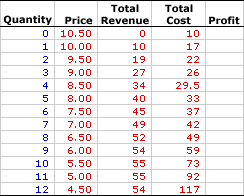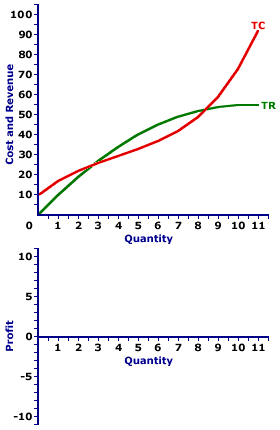
|
|
RESOURCE: The labor, capital, land, and entrepreneurship used by society to produce consumer satisfying goods and services. Land provides the basic raw materials--vegetation, animals, minerals, fossil fuels--that are inputs into the production of goods (natural resources). Labor is the resource that does the "hands on" work of transforming raw materials into goods. Capital is the comprehensive term for the vast array of tools, equipment, buildings, and vehicles used in production. Entrepreneurship is the resource that undertakes the risk of bringing the other resources together and initiating the production process.
Visit the GLOSS*arama
|
|


|

|
                           MONOPOLY, PROFIT ANALYSIS: A monopoly produces the profit-maximizing quantity of output that generates the highest level of profit. This profit approach is one of three methods that used to determine the profit-maximizing quantity of output. The other two methods involve a comparison of total revenue and total cost or a comparison of marginal revenue and marginal cost. Monopoly is a market in which a single firm is the only supplier of the good. Anyone seeking to buy the good must buy from the monopoly seller. This single-seller status gives monopoly extensive market control--a price maker that faces a negatively-sloped demand curve. With this negatively-sloped demand curve, marginal revenue is less than average revenue and price.Comparable to any profit-maximizing firm, a monopoly produces the quantity of output in the short run that generates the maximum difference between total revenue and total cost, which is economic profit. At this production level, the firm cannot increase profit by changing the level of production. The analysis of profit can be achieved through a table of numbers or by a comparison of total revenue and total cost curves. Working the NumbersA monopoly is presumed to produce the quantity of output that maximizes economic profit--the difference between total revenue and total cost. This decision can be analyzed using the exhibit below. This table presents revenue and cost information for Feet-First Pharmaceutical, a hypothetical example of a monopoly, for the production and sale of Amblathan-Plus, the only cure for the deadly (but hypothetical) foot ailment known as amblathanitis.Because Feet-First Pharmaceutical produces a unique product it has extensive market control and sells its Amblathan-Plus according to the market demand. To sell a larger quantity, it must lower the price. Feet-First Pharmaceutical's status as a monopoly firm is reflected in this table. | The Numbers |  |
- Quantity: The quantity of output produced by the Feet-First Pharmaceutical, presented in the first column, ranges from 0 to 12 ounces of Amblathan-Plus. While, Feet-First Pharmaceutical could produce more than 12 ounces, this range is sufficient for the present analysis.
- Price: The second column presents the price received by Feet-First Pharmaceutical for selling Amblathan-Plus. As a price maker, the first and second columns represent the market demand for Amblathan-Plus. The price Feet-First Pharmaceutical faces ranges from a high of $10.50 per ounce for a zero quantity to a low of $4.50 per ounce for 12 ounces. Feet-First Pharmaceutical can sell a larger quantity of Amblathan-Plus, but only by reducing the price. Feet-First Pharmaceutical is a price maker.
- Total Revenue: Total revenue is presented in the third column. This indicates the revenue Feet-First Pharmaceutical receives at each level of Amblathan-Plus production. It is derived as the quantity in the first column multiplied by the price in the second column. Total revenue ranges from $0 if no output is sold to a high of $55 for selling 10 or 11 ounces of Amblathan-Plus. For example, selling 4 ounces of Amblathan-Plus generates $34 of revenue and selling 7 ounces leads to $49 of revenue.
- Total Cost: The fourth column presents the total cost incurred by Feet-First Pharmaceutical in the production of Amblathan-Plus, ranging from a low of $10 for zero output (which is fixed cost) to a high of $117 for 12 ounces. Total cost continues to rise beyond 12 ounces, but this information is not needed. Producing 1 ounce of Amblathan-Plus incurs a total cost of $17. Producing 2 ounces of Amblathan-Plus incurs a total cost of $22. Total cost rises as Feet-First Pharmaceutical produces more.
- Profit: The fifth column at the far right of the table is available to display economic profit, the difference between total revenue in the third column and total cost in the fourth column. A click of the [Profit] button displays Feet-First Pharmaceutical's economic profit in the fifth column.
The task is to determine the economic profit Feet-First Pharmaceutical earns for each quantity of Amblathan-Plus produced, then to identify which Amblathan-Plus production level provides the maximum profit. A click of the [Incurring Losses] button indicates that producing and selling 1 ounce of Amblathan-Plus generates an economic loss of $7. Total revenue is $10 and total cost is $17. A $3 loss results from 2 ounces of Amblathan-Plus. Feet-First Pharmaceutical incurs an economic loss for the first 2 ounces of Amblathan-Plus. Feet-First Pharmaceutical also incurs an economic loss if production is 9 ounces or more. But loss is not what Feet-First Pharmaceutical seeks. Click the [Earning Profits] button to highlight the range of production levels that generate positive economic profit. Feet-First Pharmaceutical initially turns its profit picture around with 3 ounces of Amblathan-Plus. At 3 ounces of Amblathan-Plus Feet-First Pharmaceutical's total revenue is greater than its total cost by $1. Profit remains positive through the production of 8 ounces of Amblathan-Plus, Feet-First Pharmaceutical's total revenue exceeds total cost and it receives an economic profit. For 5 ounces of Amblathan-Plus, this profit is $7, for 6 ounces profit is $8, and for 7 ounces profit drops back to $7 again. So what is the profit-maximizing level of Amblathan-Plus production Feet-First Pharmaceutical should undertake? The desired production level is clearly not 2 ounces or less, nor is it 9 ounces or more, all of which lead to economic loss. It must be within the highlighted range between 3 and 8. The quantity that generates the greatest of economic profit is 6 ounces of Amblathan-Plus. This alternative can be highlighted by clicking the [Profit Max] button. The production of 6 ounces of Amblathan-Plus results in $45 of total revenue and $37 of total cost, a difference of $8. No other production level generates a greater economic profit. Producing 1 more ounce of Amblathan-Plus or 1 less ounce of Amblathan-Plus reduces profit to $7. Working the Curves| The Amblathan-Plus Curves |  |
The short-run production decision for a monopoly can be graphically illustrated by deriving a profit curve from the total revenue and total cost curves. The lower panel of the exhibit to the right is standing poised to display the profit curve for Amblathan-Plus production.- Total Revenue: The hump-shaped green line labeled TR depicts the total revenue that Feet-First Pharmaceutical receives from Amblathan-Plus production. The line is hump-shaped because Feet-First Pharmaceutical faces a negatively-sloped demand curve.
- Total Cost: The curvy red line labeled TC represents the total cost that Feet-First Pharmaceutical incurs in the production of Amblathan-Plus. The shape is based on increasing, then decreasing marginal returns.
- Profit: The vertical difference between these two lines is economic profit. If the total revenue line is above the total cost line in the middle of the diagram, economic profit is positive. If the total revenue line is below the total cost line at the far right and far left, economic profit is negative. The profit curve can be displayed in the lower panel by clicking the button labeled [Profit Curve].
Three segments of this profit curve are worth noting.- First, profit is negative (that is, Feet-First Pharmaceutical incurs an economic loss) for small quantities of output where the profit curve lies below the horizontal axis. Feet-First Pharmaceutical does not want to produce in this range.
- Second, profit is positive for larger quantities of output where the profit curve rises above the horizontal axis. Feet-First Pharmaceutical wants to produce in this range.
- Third, profit then becomes negative once again for the largest quantities of output where the profit curve dips below the horizontal axis again.
The key for Feet-First Pharmaceutical is to identify the production level that attains the peak of the profit curve. This is probably evident by looking at the exhibit, but it can be highlighted by clicking the [Profit Max] button. The output quantity identified is, once again, 6 ounces of Amblathan-Plus.Before leaving this graph, two other quantities can be highlighted. The profit curve intersects the horizontal axis (meaning profit is zero) at two quantities--at just under 3 ounces of Amblathan-Plus and about 8.5 ounces of Amblathan-Plus. Click the [Breakeven] button to highlight these two output levels. Both quantities are termed breakeven output. Breakeven output is a quantity of output in which the total revenue is equal to total cost such that a firm earns exactly a normal profit, and thus receives no economic profit nor incurs an economic loss. The reason for the term "breakeven" output is that the firm is just "breaking even." It is neither making a profit nor incurring a loss. Economic profit is zero. Breakeven output is usually most noteworthy as a reference point. The profit-maximizing production level invariably occurs between the two breakeven output levels.

Recommended Citation:MONOPOLY, PROFIT ANALYSIS, AmosWEB Encyclonomic WEB*pedia, http://www.AmosWEB.com, AmosWEB LLC, 2000-2025. [Accessed: July 18, 2025].
Check Out These Related Terms... | | | | | | | |
Or For A Little Background... | | | | | | | | | |
And For Further Study... | | | | | | |
Search Again?
Back to the WEB*pedia
|



|

|
BLUE PLACIDOLA
[What's This?]
Today, you are likely to spend a great deal of time searching the newspaper want ads looking to buy either a wall poster commemorating the first day of winter or blue cotton balls. Be on the lookout for rusty deck screws.
Your Complete Scope
This isn't me! What am I?
|

|
|
Helping spur the U.S. industrial revolution, Thomas Edison patented nearly 1300 inventions, 300 of which came out of his Menlo Park "invention factory" during a four-year period.
|

|
|
"A winner is someone who recognizes his God-given talents, works his tail off to develop them into skills, and uses those skills to accomplish his goals. " -- Larry Bird, basketball player
|

|
LISH
last In Still Here
|

|
|
Tell us what you think about AmosWEB. Like what you see? Have suggestions for improvements? Let us know. Click the User Feedback link.
User Feedback
|


|


